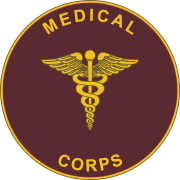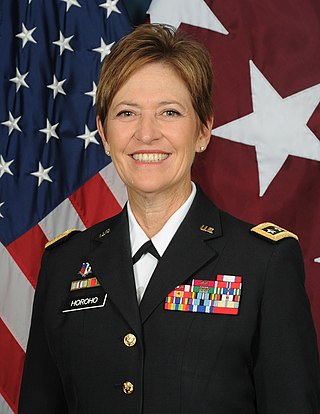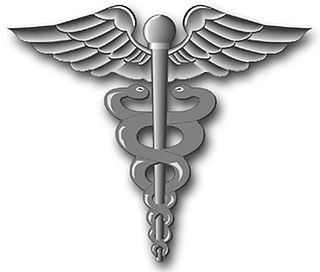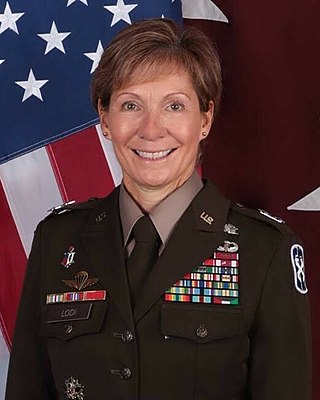Corps is a term used for several different kinds of organization. A military innovation by Napoleon I, the formation was first named as such in 1805. The size of a corps varies greatly, but two to five divisions and anywhere from 40,000 to 80,000 are the numbers stated by the US Department of Defense.

The U.S. Army Medical Command (MEDCOM) is a direct reporting unit of the U.S. Army that formerly provided command and control of the Army's fixed-facility medical, dental, and veterinary treatment facilities, providing preventive care, medical research and development and training institutions. On 1 October 2019, operational and administrative control of all military medical facilities transitioned to the Defense Health Agency.

The Walter Reed Army Medical Center (WRAMC), officially known as Walter Reed General Hospital (WRGH) until 1951, was the U.S. Army's flagship medical center from 1909 to 2011. Located on 113 acres (46 ha) in Washington, D.C., it served more than 150,000 active and retired personnel from all branches of the United States Armed Forces. The center was named after Walter Reed, a U.S. Army physician and sergeant who led the team that confirmed that yellow fever is transmitted by mosquitoes rather than direct physical contact.

The Army Medical Department of the U.S. Army (AMEDD), formerly known as the Army Medical Service (AMS), encompasses the Army's six medical Special Branches. It was established as the "Army Hospital" in July 1775 to coordinate the medical care required by the Continental Army during the Revolutionary War. The AMEDD is led by the Surgeon General of the U.S. Army, a lieutenant general.

The U.S. Army Veterinary Corps is a staff corps of the U.S. Army Medical Department (AMEDD) consisting of commissioned veterinary officers and Health Professions Scholarship Program (HPSP) veterinary students. It was established by an Act of Congress on 3 June 1916. Recognition of the need for veterinary expertise had been evolving since 1776 when General Washington directed that a "regiment of horse with a farrier" be raised. It has evolved to include sanitary food inspectors and animal healthcare specialists.

The Medical Corps (MC) of the U.S. Army is a staff corps of the U.S. Army Medical Department (AMEDD) consisting of commissioned medical officers – physicians with either an M.D. or a D.O. degree, at least one year of post-graduate clinical training, and a state medical license.

Valley Forge General Hospital is a former military hospital in Phoenixville, Pennsylvania. The hospital was near both Philadelphia, Pennsylvania and Valley Forge. It was the only United States Army General Hospital named for a place.

William Beaumont Army Medical Center is a Department of Defense medical facility located in Fort Bliss, Texas. It provides comprehensive care to all beneficiaries including active duty military, their family members, and retirees. The hospital is located in the Central/Northeastern part of El Paso, and provides emergency department services for Northeast El Paso. The current 1.1-million-square-foot, 6-building medical complex opened July 10, 2021, on East Fort Bliss. WBAMC is affiliated with the Paul L. Foster School of Medicine which is also located in El Paso, Texas. WBAMC is also a participating hospital for medical residents from the Uniformed Services University of the Health Sciences (USU) and nursing students from the University of Texas at El Paso School of Nursing and the El Paso Community College Nursing School.

The Surgeon General of the United States Army is the senior-most officer of the U.S. Army Medical Department (AMEDD). By policy, the Surgeon General (TSG) serves as Commanding General, U.S. Army Medical Command (MEDCOM) as well as head of the AMEDD. The surgeon general's office and staff are known as the Office of the Surgeon General (OTSG) and are located in Falls Church, Virginia.

The U.S. Army Medical Department Museum — or AMEDD Museum — at Fort Sam Houston, San Antonio, Texas, originated as part of the Army's Field Service School at Carlisle Barracks, Pennsylvania. It moved to Fort Sam Houston in 1946. It is currently a component of the U.S. Army Medical Department Center and School.
The Basic Officer Leader Course (BOLC) is a two-phased training course designed to commission officers and prepare them for service in the United States Army. Prospective officers complete Phase I as either a cadet or an officer candidate before continuing on to BOLC B as Second Lieutenants. If BOLC B is not completed within two years of commissioning, 2LTs will be administratively separated from the service unless there are extenuating circumstances. This a progressive model designed to produce US Army officers with leadership skills, small unit tactics and certain branch-specific capabilities.

Brigadier General Robin Umberg, Deputy Commander Clinical Services 3rd Medical Command, is one of several female United States Army general officers.

This article incorporates public domain material from websites or documents of the United States Army.

The U.S. Army Public Health Center (APHC) is a United States Army element headquartered at Aberdeen Proving Ground, Maryland, United States. As a forward operating agency of the United States Army Medical Command, APHC is responsible for providing technical support and expertise in the areas of preventive medicine, public health, health promotion, and wellness to military units around the globe.

The U.S. Army Medical Center of Excellence (MEDCoE) is located at Fort Sam Houston, Joint Base San Antonio, Texas. MEDCoE comprises the 32d Medical Brigade, the U.S. Army Medical Professional Training Brigade (MPTB), and the AMEDD Noncommissioned Officers Academy (NCOA). It serves the U.S. Army in educating and training all of its medical personnel. The Center formulates the Army Medical Department's (AMEDD's) organization, tactics, doctrine, equipment, and academic training support. In 2015, the mission for the Academy of Health Sciences (AHS) moved from the School to the Center, and was renamed the Department of Training and Academic Affairs (DoTAA) as result of a reorganization.
The United States Army Medical Department (AMEDD) Captains Career Course (CCC) is an Officer Advance Course (OAC) taught at Fort Sam Houston, Texas that provides graduate level leadership training for all six special officer branches (corps) in the AMEDD.

Patricia D. Horoho is a retired United States Army lieutenant general who served as the 43rd Surgeon General of the United States Army and Commanding General of the United States Army Medical Command. She was the second female Nurse Corps officer to hold the title of Army surgeon general but the first to be appointed and hold the position for a full term. In 2016, she was inducted into the United States Army Women's Foundation Hall of Fame.

United States Army Hospital Corps was organized in 1886 in order to recruit and retain competent medical enlisted personnel in the United States Army Medical Department for field service in the event of a foreign war. Existing Hospital Stewards were not trained to perform duties as field medical personnel. The Corps was recruited from enlisted men who had served one year in the line. After training they were transferred to a post where they would be assigned duties as nurse, cook or medical attendant. Privates having served twelve months in the Corps could be recommended for promotion. Having passed an examination they were promoted to Acting Hospital Stewards (Sergeant). Promotion to full Hospital Steward was possible after one year's service in an acting capacity and after having passed a second and more rigorous examination. The peak strength of the Corps was reached in November 1898, during the Spanish–American War, with about 6,000 men serving in the Corps.

Paula C. Lodi is a United States Army major general who serves as Commanding General of the 18th Medical Command since June 15, 2022. She previously served as Deputy Commanding General for Support of the United States Army Medical Command from July 2021 to May 2022. Lodi was the first female commander of the 44th Medical Brigade. She is also the younger sister of Lieutenant General Maria Barrett. Lodi and Barrett are the United States Army's first ever sister General Officer tandem.

The United States Army Medical Command, Vietnam (USAMEDCOMV) provided Echelon/Role 3 Health Service Support to units of the United States Army, Vietnam (USAV). It was a Table of Distribution and Allowances organization created by consolidating the staffs of the 44th Medical Brigade and the USAV Surgeon's Office. This action was taken as part of the overall drawdown of forces in Vietnam in an effort to reduce headquarters staffs and increase efficiencies. As the medical footprint further reduced in 1972, it was replaced by the United States Army Health Services Group, Vietnam on 30 April 1972.

















